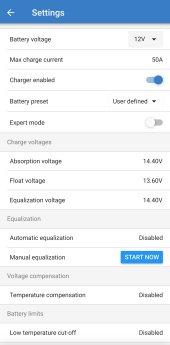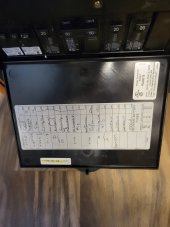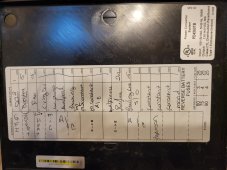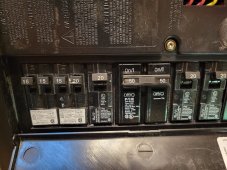You are using an out of date browser. It may not display this or other websites correctly.
You should upgrade or use an alternative browser.
You should upgrade or use an alternative browser.
Victron. Want to hire an expert. Around SE.
- Thread starter Barryga
- Start date
No, but.The reading on the ac/dc panel is hard to read, but I think the second breaker from the left is labeled "inverter".
I'll bet that actually means converter and I notice it is on.
I further guess it means there is no 12 volt feed from the batteries.
From which I further guess that the converter is being powered by an inverter which means the efficiency will be just pathetic.
In that case the core system should have been 24 or 48 volts.
@Barryga if you turn off the second breaker does your dc power go away?
Lights inside are on, but all 110 power is off, fridge, electric heater only DC items work
John Frum
Tell me your problems
- Joined
- Nov 30, 2019
- Messages
- 15,230
What the foop is this soup?No, but.
Lights inside are on, but all 110 power is off, fridge, electric heater only DC items work
John Frum
Tell me your problems
- Joined
- Nov 30, 2019
- Messages
- 15,230
Are you connected to shore power?What the foop is this soup?
@Barryga what is 20 amp breaker on th
Attachments
Last edited:
Not when I turned the inverter off,Are you connected to shore power?
Just now plugged in as ran batteries down to 11.6 amps.
John Frum
Tell me your problems
- Joined
- Nov 30, 2019
- Messages
- 15,230
No that is a dc disconnect switch.If this is the one second picture goes into bottom of the inverter see on bottom right., the wire on left of switch
I mean the breaker on far right of the ac distribution panel.
I can't tell what is written on it but it might be the converter breaker.
I want to see if you have a dc from your batteries into the dc distribution panel or if the power for the dc distribution panel comes from your ac2dc converter.
Did you turn off the breaker 2nd from the left in the ac distribution panel the first time or something else?
Inverter.Is that picture from the battery compartment or the inverter compartment?
Assuming you mean volts and not amps, keep in mind that 11.6V for LiFePO₄ is about 7% SOC.Just now plugged in as ran batteries down to 11.6 amps.
Ac fuse in the center.No that is a dc disconnect switch.
I mean the breaker on far right of the ac distribution panel.
I can't tell what is written on it but it might be the converter breaker.
I want to see if you have a dc from your batteries into the dc distribution panel or if the power for the dc distribution panel comes from your ac2dc converter.
Did you turn off the breaker 2nd from the left in the ac distribution panel the first time or something else?
Attachments
John Frum
Tell me your problems
- Joined
- Nov 30, 2019
- Messages
- 15,230
Well that explains why you lost all ac power.Ac fuse in the center.
That is the master breaker.
The breakers I am interested in are 2nd 15 amp breaker from the left and the 20 amp breaker on the far right.
I had 50 amp service run from my garageAssuming you mean volts and not amps, keep in mind that 11.6V for LiFePO₄ is about 7% SOC.
I leave the motorhome plugged in when parked
As a 1500 watt elec heater, I keep it at 50, and in summer, I keep the air set at 80.
So somehow got in mind today batteries need discharge or be stored at 50%.
I have not done that until today.
2nd 15 says booster the far right 2 20 say contantWell that explains why you lost all ac power.
That is the master breaker.
The breakers I am interested in are 2nd 15 amp breaker from the left and the 20 amp breaker on the far right.
John Frum
Tell me your problems
- Joined
- Nov 30, 2019
- Messages
- 15,230
That is the dc fuse map.2nd 15 says booster the far right 2 20 say contant
Look at the ac breaker map.
Im lost, not a clue.That is the dc fuse map.
Look at the ac breaker map.
John Frum
Tell me your problems
- Joined
- Nov 30, 2019
- Messages
- 15,230
I give up.Im lost, not a clue.
Well, sorry, but this is over my head.I give up.
I appreciate the effort, but you can't teach a stump, and you tried.
In post #5, the last picture you posted shows the inside of the DC fuse and AC breaker panel. The door has a map of the DC fuses and AC breakers. On the left side, at the top of the columns, it says "AC branch circuits" and "DC branch circuits". @smoothJoey is asking about the AC column list.
It shows GFI, Invert, W. Heat, etc.
Those are for the bottom row of AC breakers. the ones with the little switches with numbers like 15 and 20 on them.
The DC column is for the DC fuses along the top. Most are blue with a 15 on them and a yellow 20.
It shows GFI, Invert, W. Heat, etc.
Those are for the bottom row of AC breakers. the ones with the little switches with numbers like 15 and 20 on them.
The DC column is for the DC fuses along the top. Most are blue with a 15 on them and a yellow 20.
John Frum
Tell me your problems
- Joined
- Nov 30, 2019
- Messages
- 15,230
When the inverters are inverter mode I suspect each one will have a neutral/ground bond.
scenario:
Line 1 shorts to ground
Fault current travels via ground wire to the neutral/ground bond in inverter 1
then it takes neutral to the inverter 1 transformer
But the fault current also travels via ground wire the the neutral/ground bond in inverter 2
then it takes neutral back to the neutral busbar in the panel and then takes the neutral wire to inverter 1.
I think that would be objectionable current.
scenario:
Line 1 shorts to ground
Fault current travels via ground wire to the neutral/ground bond in inverter 1
then it takes neutral to the inverter 1 transformer
But the fault current also travels via ground wire the the neutral/ground bond in inverter 2
then it takes neutral back to the neutral busbar in the panel and then takes the neutral wire to inverter 1.
I think that would be objectionable current.
404 Error - Page Not Found
Ready to take an electrical exam? For over 40 years we have been designing electrical exam preparation products that work. Choose one of our best-selling products and get the skills, the knowledge and the confidence you need to pass your exam.
www.mikeholt.com
CamoGreg
5 yr RV Fulltimer
- Joined
- Jun 18, 2020
- Messages
- 156
The 20A fuse label on the right looks to spell "Convort" to me. Written top to bottom. That is also the same location both my RVs had the converter breaker.
Since this is a Class C with an engine battery, I wonder if they left the original house batteries in place to power the DC loads?
The house batteries often are connected to a boost switch to apply all 12V batteries to help a start the engine in the event of a weak engine battery.
@Barryga , do you know if the original 12V lead acid house batteries are still there or did they remove them when installing the SOKs?
Since this is a new Super C motorhome, did it by chance come with a residential style refrigerator? Or will it run on propane?
If residential style, that may be why the "Invert" breaker. There may be a small inverter to run the fridge tucked away somewhere.
Since this is a Class C with an engine battery, I wonder if they left the original house batteries in place to power the DC loads?
The house batteries often are connected to a boost switch to apply all 12V batteries to help a start the engine in the event of a weak engine battery.
@Barryga , do you know if the original 12V lead acid house batteries are still there or did they remove them when installing the SOKs?
Since this is a new Super C motorhome, did it by chance come with a residential style refrigerator? Or will it run on propane?
If residential style, that may be why the "Invert" breaker. There may be a small inverter to run the fridge tucked away somewhere.
Last edited:
No, the two house batteries I gave away.The 20A fuse label on the right looks to spell "Convort" to me. Written top to bottom. That is also the same location both my RVs had the converter breaker.
Since this is a Class C with an engine battery, I wonder if they left the original house batteries in place to power the DC loads?
The house batteries often are connected to a boost switch to apply all 12V batteries to help a start the engine in the event of a weak engine battery.
@Barryga , do you know if the original 12V lead acid house batteries are still there or did they remove them when installing the SOKs?
Since this is a new Super C motorhome, did it by chance come with a residential style refrigerator? Or will it run on propane?
If residential style, that may be why the "Invert" breaker. There may be a small inverter to run the fridge tucked away somewhere.
The cummings have two separate batteries, but when running, it will charge the solar lithiums.
The fridge is 110 volt only.
Sorry I missed this yesterday
Similar threads
- Replies
- 44
- Views
- 1K
- Replies
- 3
- Views
- 347
- Replies
- 31
- Views
- 2K







